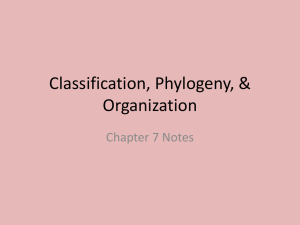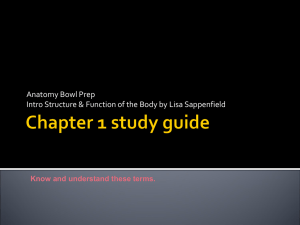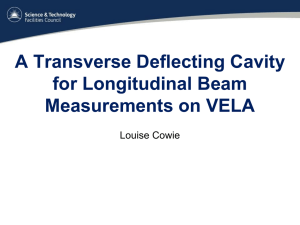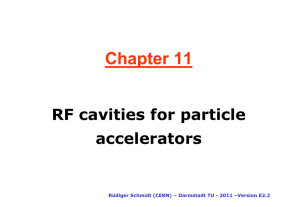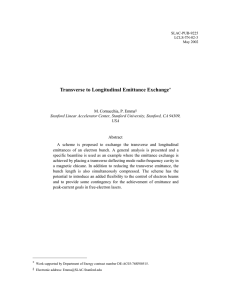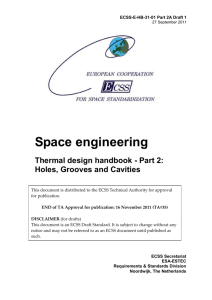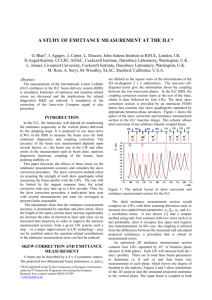The Most General Transverse to Longitudinal Emittance Exchanger
advertisement
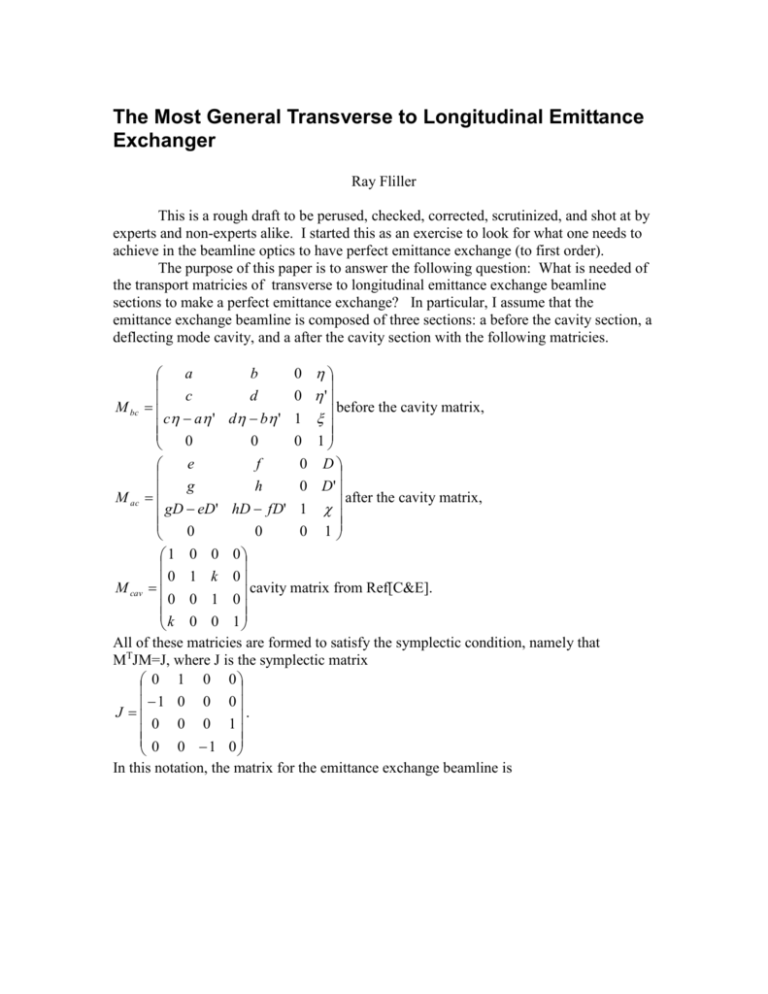
The Most General Transverse to Longitudinal Emittance Exchanger Ray Fliller This is a rough draft to be perused, checked, corrected, scrutinized, and shot at by experts and non-experts alike. I started this as an exercise to look for what one needs to achieve in the beamline optics to have perfect emittance exchange (to first order). The purpose of this paper is to answer the following question: What is needed of the transport matricies of transverse to longitudinal emittance exchange beamline sections to make a perfect emittance exchange? In particular, I assume that the emittance exchange beamline is composed of three sections: a before the cavity section, a deflecting mode cavity, and a after the cavity section with the following matricies. a b 0 c d 0 ' before the cavity matrix, M bc c a ' d b ' 1 0 0 0 1 e f 0 D g h 0 D' after the cavity matrix, M ac gD eD' hD fD' 1 0 0 0 1 1 0 0 0 0 1 k 0 M cav cavity matrix from Ref[C&E]. 0 0 1 0 k 0 0 1 All of these matricies are formed to satisfy the symplectic condition, namely that MTJM=J, where J is the symplectic matrix 0 1 0 0 1 0 0 0 J . 0 0 0 1 0 0 1 0 In this notation, the matrix for the emittance exchange beamline is d f (1 + k ) + b (e + kD - f ' )) c f (1 + k ) + a (e + k ( D - f ' )) d h (1 + k ) + b (g + k (D' - h ' )) c h (1 + k ) + a (g + k ( D ' - h ' )) M c (hD - fD ' ) + (1 + h kD - f kD ' ) (c - d (hD - f D' ) + (1 + h kD - f kD' ) (d a ' ) + a (gD - eD ' + k ) b ' ) + b (gD - eD' + k ) a k bk fk D + e + k D + f ( ' + k ) hk D' + g + k D' + h ( ' + k ) gD - e D' + h D ' 1 hkD - fkD' f D' '+ + h k D f k D' + (1 + k ) 0 1 + k To simplify notation, I will refer to the emittance exchanger matrix with the notation of Reference [C&E] A B M C D where A, B, C, D represent 2x2 blocks of the matrix. Following from Equation 28 of C&E, we require that det A 0 . 2 0 It is stated in Ref [C&E] that if all of the elements of the A block are zero, then 2 0 automatically. I have verified this and will include it in a subsequent draft. Nonetheless, to design a beamline with perfect emittance exchange we need to produce a matrix with the A block to be all zeros. As a consequence of this and the symplecticity of the matrix, the following will automatically be true: det B 1 det C 1 . det D 0 What is not required from these considerations is that the D block be all zeros. However, as I will show, setting the A block to all zeros will set the D block to all zeros automatically. That this should happen at all is not obvious in the paper. At this point the question becomes, what is needed of the elements of Mbc, Mcav, Mac, to make the A block of the total matrix all zeros?? There are four equations, one for each element of the A block. At first glance there are 15 unknowns (a, b, c, d, e, f, g, h, k, ', D, D’,However, the first 4 and the second 4 respectively are related by the symplectic condition. The last 2 are determined by integrals of the dispersion function for each line, this leaves 11 free parameters (a, b, c, e, f, h , k, ', D, D’. One can solve the system of equations A11=A12=A21=A22=0, and one arrives at the following relations between the free parameters: k 1 D e f ' D' Dh f Plugging these into the matrix for the emittance exchange, one gets 0 0 M c a ' a a 0 f 0 h d b 'b b 0 0 e f ' f g h 'h 0 0 Now I will note the following interesting points of the solution. Firstly, it is general involving only the properties of the cavity, symplectic transport lines, and perfect emittance exchange. The second is that the solution of the cavity strength is only determined by the dispersion in the cavity. It is not obvious that it should not depend on other things, such as the slope of the dispersion through the cavity. Thirdly, the requirements of the after cavity transport only depend on the dispersion and its slope in the cavity. It does not depend on the other elements of the transport matrix prior to the cavity. And fourth, a beamline that returns the dispersion and its slope to zero in the absence of the deflecting mode cavity (such as the chicane in the C&E paper with k=0), cannot be a perfect emittance exchanger. The requirements to zero the dispersion and slope in the absence of the cavity are D e f ' D' Dh f . Which cannot be satisfied with the conditions of perfect emittance exchange. However, a beamline such as the double dog-leg proposed in SLAC-PUB-12038 (that is the paper that Philippe is co-author) can. In fact if one uses a d e h 1 b f L , ' 0 One can reproduce equations 25 and 26 of the paper. Any questions?? Mistakes??


